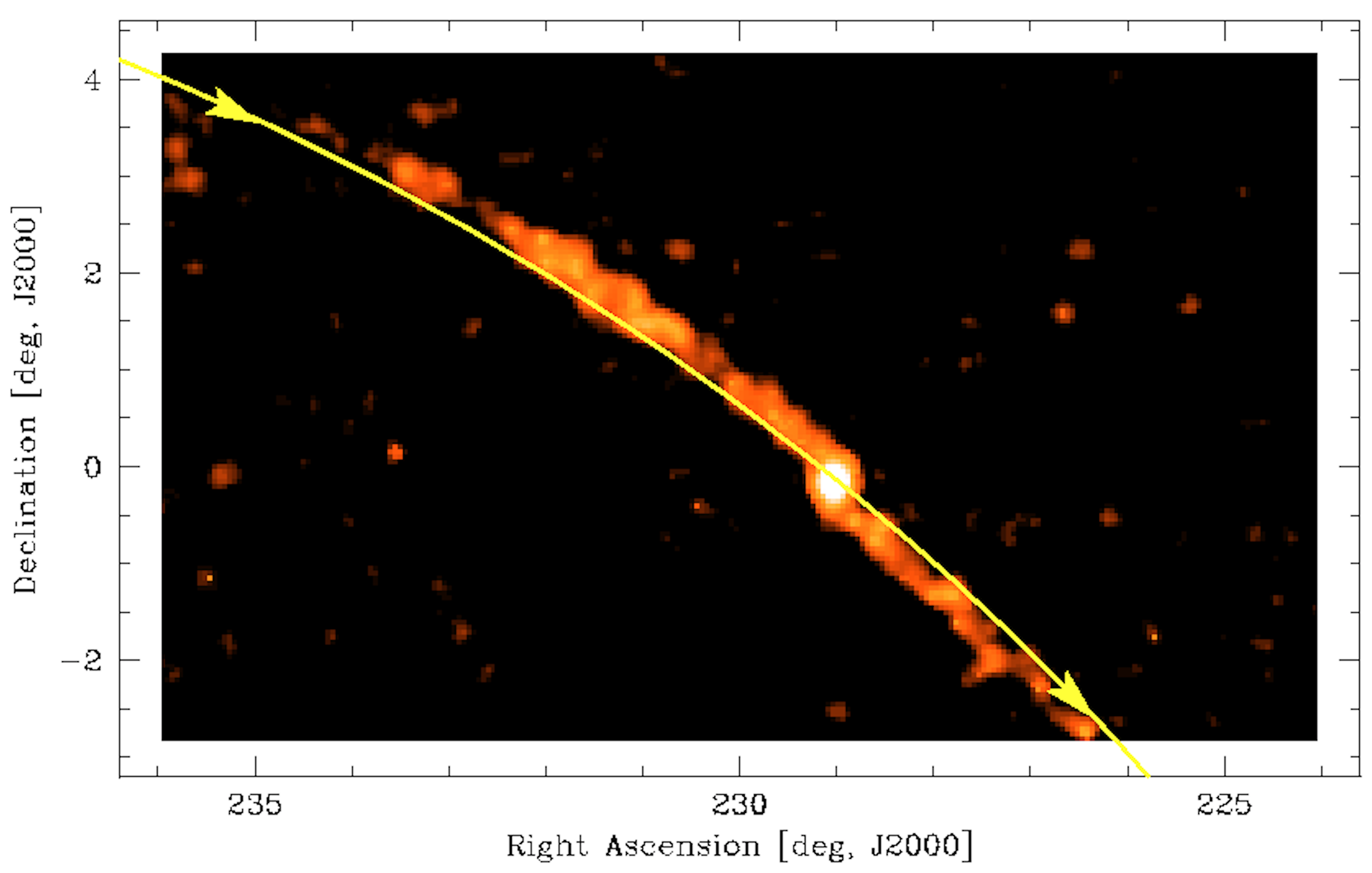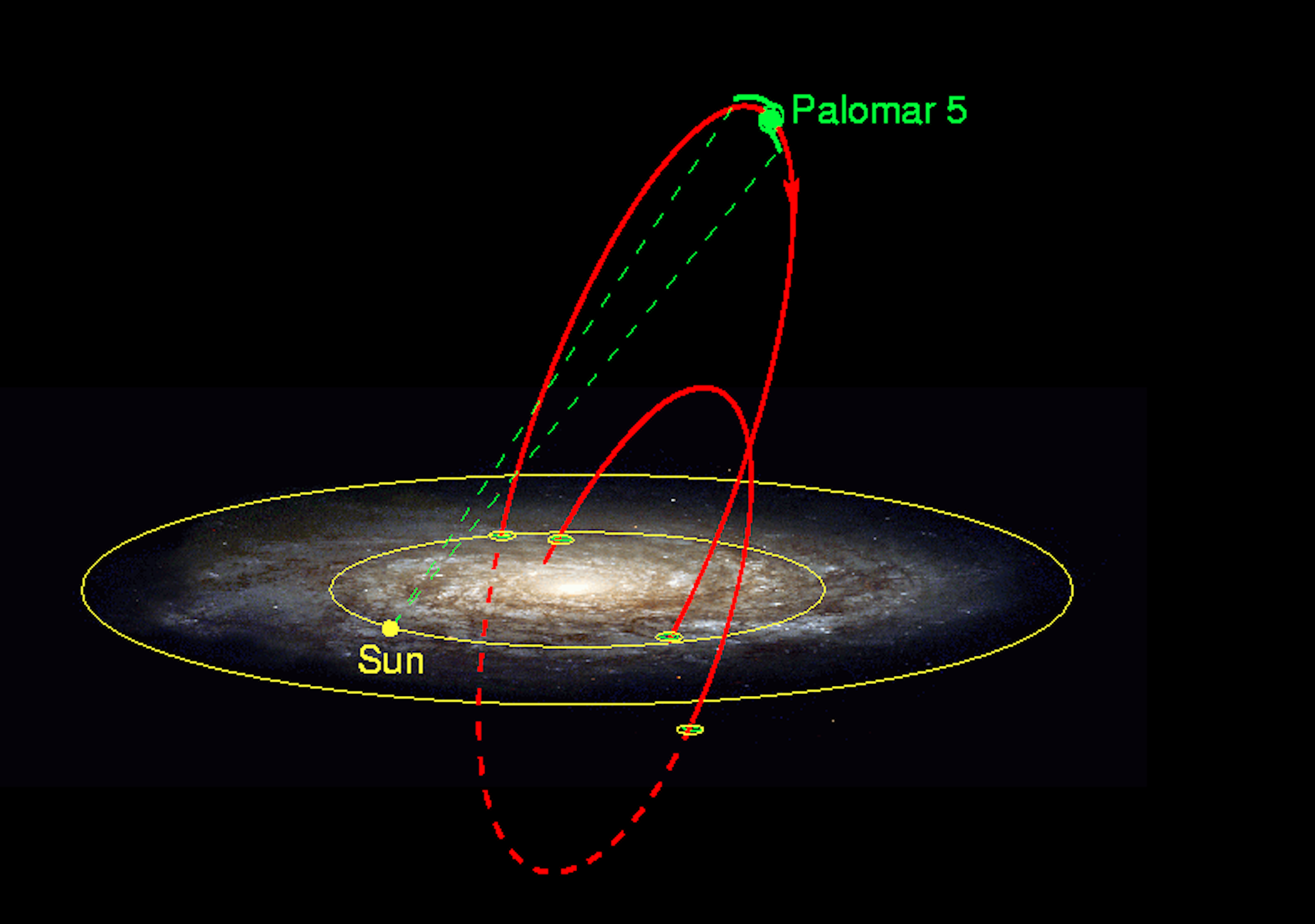Black Holes Are Slowly Taking Over a Cluster that Orbits Our Galaxy
July 5, 2021Palomar 5, a sprawled-out cluster of ancient stars that orbits the Milky Way, is flanked by two enormous tails of stars that extend across 30,000 light years, a feature that has long fascinated and puzzled scientists. It’s clear that the tails are made of stars that have been gravitationally ejected from the cluster over time, but the exact mechanism that produced the unusually long stellar stream at Palomar 5 remains a mystery.
Now, scientists led by Mark Gieles, an astrophysicist at the Catalan Institution for Research and Advanced Studies at the University of Barcelona, have proposed an evocative explanation: Black holes are slowly but surely taking over Palomar 5, a process that is kicking out stars at an accelerated rate.
In about one billion years, the black holes at Palomar 5 will succeed in their total usurpation of the system, causing Palomar 5 to “dissolve as a 100 percent black hole cluster,” according to a study published on Monday in Nature Astronomy.
Gieles has been ruminating on the dynamics of systems like Palomar 5, which are known as globular clusters due to their roughly spherical shape, for more than a decade. The advent of gravitational wave astronomy, a field that uses ripples in spacetime to study extreme objects such as black holes, has shed new light on the dynamics that may be shaping the evolution of these enigmatic clusters.
“Palomar 5 with its stream is truly unique, and is a sort of Rosetta Stone for understanding stream formation,” said Gieles in an email. “Because of the discovery of gravitational waves, myself and others started looking in more detail what happens when a star cluster has black holes, and then I realized that the high escape rate and the large radius of Palomar 5 might both be the result of a massive population of black holes.”
“Combined with the above, I decided that we should try to model Palomar 5 and its stream and see if all peculiar properties can be explained with black holes,” he added.

In addition to its extended tails, Palomar 5 is one of the most sparsely populated clusters in the Milky Way, meaning that it doesn’t have many stars left in the central structure between the two tails. These features contrast with other large star structures that orbit the Milky Way, which include bulky clusters that have no tails and disembodied tails that have no central cluster.
Gieles’ team suspect that Palomar 5 once had a normal ratio of black holes to stars billions of years ago, with black holes only accounting for a few percent of the cluster’s overall mass. But whenever the cluster makes its closest orbital approach to the Milky Way, the gravitational forces in our galaxy strip stars out of the system, creating the distinctive tails and leaving behind an ever-accumulating population of black holes.
“Because the black holes are more massive than the stars, they experience what is called dynamical friction: they slow down due to interactions with the stars,” Gieles explained. “As a result they sink to the center, where they are ‘safe.’ Stars are being stripped from the outer part every time the cluster passes near the Galactic center or crosses the disc. When you remove stars, but not black holes, the black hole fraction goes up!”
“However, this does not happen for all clusters because black holes are also ejected from the cluster, as the result of interactions between binary black holes and other black holes,” he continued. “Whether this process is faster, or slower than stripping of stars, depends on the initial mass and density of the star cluster.”

According to the models developed by the team, the odd features of Palomar 5 could be explained with a black hole population that has grown to a fifth of the system’s mass. As the cluster continues to lose its stars, the system will eventually be entirely taken over by black holes, in about one billion years.
This new study is based on simulations of Palomar 5, but Gieles and his colleagues are optimistic that they can obtain observational evidence to back up their hypothesis by closely examining the system’s interior dynamics using telescopes. In addition, the team plans to take another look at those disembodied streams of stars that seem to have no progenitor clusters, as these structures may reveal the final form of a black hole takeover.
“We want to look at the mass in progenitor-less streams, and understand whether black holes are needed for this as well,” Gieles said, an avenue of research that “has several implications for our understanding of globular cluster formation and evolution.”
